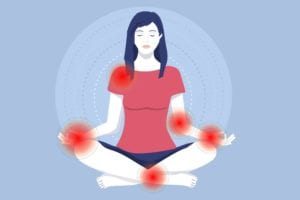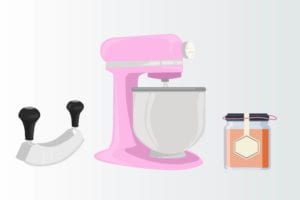Dancing, dinnertime, family game night, sports — so many of life’s most fun moments happen in the evenings. Yet for many people living with arthritis, those activities and events may feel off-limits because their evenings are consumed by pain and fatigue.
“Evenings are the worst time of day for me as far as swelling, stiffness, and pain go,” says Emily S., 31, of Council Bluffs, Iowa. “It just gets worse as the day goes on. By bedtime my joints even look more deformed and the pressure is insane.” At first she wondered if this was a sign that her rheumatoid arthritis was a misdiagnosis because it seemed like the opposite was true for most people; many patients with inflammatory arthritis note that their symptoms often feel worse in the morning. “You just don’t hear about evening problems as much but for me that’s when it all hits,” she says.
The evening hours may not get as much attention as the morning but if you feel worse at night, you’re definitely not alone. Over a quarter of patients with inflammatory arthritis reported evening pain, with the majority of those saying that increased joint inflammation was the biggest problem, according to a study published in the journal Annals of Rheumatic Diseases.
But you don’t have to give up your evenings to your arthritis — there are ways to help you cope and even thrive through those hours until bedtime.
Evening challenge: My pain is so much worse
1. Take your pain medication in the evening
Many people choose to take their pain medications in the morning but there’s nothing that says you must do this, says Aly Cohen, MD, a rheumatologist at Integrative Rheumatology Associates in Princeton, New Jersey, and founder of The Smart Human. “If it hurts worse at night, it’s usually fine to switch to taking them in the evening or split the dose between morning and night, just check with your doctor first,” she explains. This was the key for Brittany P., 40, of Melbourne, Australia, who has rheumatoid arthritis. “My doctor prescribed me amitriptyline for nerve pain and I discovered it also makes me sleepy,” she says. “I take it 45 minutes before bed and it helps me sleep so much better. It solves two problems at the same time.”
2. Put your feet up
Elevation is a simple way to help reduce swelling and pain, which is why Brittany says the first thing she does when she gets home from work is to lie on the couch and put her feet up. “It sounds like a cliché but it’s absolutely necessary for me to put my feet up after a long day,” she says. “I use a stack of pillows to elevate them higher than my heart.”
3. Do some trigger-point massage
As soon as you’re home, take a few minutes to massage your aching joints, says A. Lee Osterman, MD, professor of hand and orthopedic surgery at Thomas Jefferson University in Philadelphia, Pennsylvania and president of the Philadelphia Hand Center. Massaging the muscles around inflamed joints can improve the circulation and decrease painful spasms, he explains. “It can be painful waiting for the trigger point to relax but if I do it every day I find my pain from rheumatoid arthritis is less overall,” says Gemma H., 44, of Las Vegas, Nevada. Ask your doctor or physical therapist to show you the right places to apply pressure.

Evening challenge: By the time I get home from work, I’m too exhausted to do anything
4. Calm your mind with a quick meditation
“This is going to sound woo-woo but my favorite way to unwind after work and get ready to do the dinner-homework-bedtime routine is to sit in my perfectly dark closet and meditate for 10 minutes,” says Michelle A., 48, of Washington, D.C., who has psoriatic arthritis. She does a meditation where she “sends love” to every part of her body — especially her joints — and thanks them for their hard work that day. “I feel like a new person when I’m done,” she adds.
5. Try CBD oil
CBD, a cannabinoid derived from hemp — a type of cannabis plant — is becoming more popular among people with arthritis and other forms of chronic pain. CBD is not intoxicating like THC, another cannabinoid found in marijuana plants. Many arthritis patients swear by using CBD for managing their symptoms. “I use a CBD tincture every day when I get home,” says Casey L., 27, of Boulder, Colorado, who has lupus. “It helps reduce the exhaustion and the pain but also my anxiety so I feel like I have more energy.” Read more about patients’ experiences using CBD for their arthritis symptoms.
6. Reenergize with yoga
Exercising may be the last thing you feel like doing when you’re exhausted but some light movement and stretching may be exactly what your body needs to feel reinvigorated for the evening. “I do a Yin class at a yoga studio three nights a week and it really helps loosen up my joints and help me calm down after a stressful day at work,” Casey says. Or you can try these gentle yoga moves for arthritis at home.
7. Eat a healthy snack
Blood sugar that is too low or too high can make you feel fatigued, Dr. Cohen says. And depending on your type of arthritis, you may be more prone to fluctuations in blood sugar. (Read more about the link between arthritis and diabetes.) Help stabilize your energy with a healthy pre-dinner mini snack that combines protein and carbs, like a handful of nuts and an apple or celery and hummus. The key is to avoid simple carbohydrates (the kind found in processed foods), which will increase blood sugar fluctuations and can contribute to inflammation.
8. Drink a big glass of water
Even mild dehydration can contribute to making you feel tired and foggy, Dr. Cohen says. Make a point to drink a tall glass of water every few hours. Not only will the water help keep your mind clear and your energy levels up but the extra fluids can help lessen joint pain as well as water is essential for proper joint function, she adds. “I drink a 16-ounce bottle of water on my commute home,” Michelle says. “I find that adding an electrolyte tablet — I use Nuun — helps my energy more than plain water.”

Evening challenge: Making dinner is painful and stressful
9. Give yourself as much freedom as possible
Many arthritis patients follow a restricted or special diet to help manage their symptoms but staying on top of what you need to eat and what you should avoid can make meal times a big source of stress. One way to lessen that is to focus on all the foods you can eat, says Susanne S., 28, of Gig Harbor, Washington, who has rheumatoid arthritis and Ehlers-Danlos syndrome. “My big trigger is sugar. If I want to feel well I can’t have any, not even a little bit, which is incredibly depressing,” she explains. “To make myself feel better, I make a point not to restrict any other aspect of my eating, which can sometimes make for wacky dinners — hello protein pancakes and peanut butter four nights in a row!”
10. Invest in an Instant Pot
Young children at home means cooking three meals a day for Lori A., 33, of Raleigh, North Carolina, who has osteoarthritis in her spine and hips. All this time in the kitchen has given her an appreciation for devices that make cooking easier, like a slow cooker, an Instant Pot (a pressure cooker), and a sous vide. “My Instant Pot is my go-to these days because all I have to do is add the ingredients and push a button,” she says. “It’s much faster than a slow cooker, which helps for days I don’t plan ahead.” Here are more tips on how to make cooking with arthritis easier.
11. Have a collection of simple recipes
One key to taking the stress out of cooking is to keep things as simple as possible — forget the complicated meals with tons of ingredients and prep and just focus on getting all the food groups on the table, Lori says. “On my good days I stick to simple meals like a marinated meat, frozen microwave veggies, and then maybe some biscuits from a can,” Lori says. “Bad days are pasta with butter or take-out.”
12. Prep meals in advance
“By the time dinner time rolls around, I’m just done,” Lori says. Her solution? Prep everything she needs for dinner in the morning. “I lay out all the ingredients on the counter or on a shelf in the fridge so I don’t have to search for things,” she says. She also prepares snacks and lunches for her kids for the whole week in advance, putting them in single-serving containers that they can just grab.
13. Have an emergency supply of freezer meals
There are days when no amount of preparation helps and you simply aren’t up for any type of cooking. For those days, Susanne says she keeps some healthy premade meals in her freezer than she can microwave or pop into the oven. Lori adds that she fills gallon-sized zip-top bags with ingredients for one-pot meals and freezes them. On bad days all she has to do is drop it into her Instant Pot.
14. Keep shoes on while you cook
Standing with your feet, knees, or hips aching from arthritis can make even the simplest evening chores, like cooking or cleaning up dinner dishes, feel agonizing. One way to minimize this is to wear comfortable, supportive shoes in your house as bare feet can intensify pain, says Yolanda Ragland, DPM, a podiatrist and founder of Fix Your Feet. Consider buying a comfortable, supportive pair of shoes or slippers for indoor use only, so you don’t drag outdoor dirt or germs all over your house.
“I bought a pair of really cushy house slippers and put them on as soon as I get home,” says Steven L., 62, of Manitoba, Canada. “Wearing them until bedtime makes a big difference with my osteoarthritis, I am able to move better and with less pain.”
Adding a cushioned mat in front of the stove or sink can also help reduce pressure on your leg and foot joints, Dr. Ragland says.
15. Equip your kitchen with ergonomic tools
Having the right tools can make all the difference in the kitchen, says Angie K., 50, of Draper, Utah, who has osteoarthritis. Dr. Osterman suggests using ergonomic tools like mounted jar openers, saw handle knives instead of flat handles, spring loaded scissors, large-grip utensils, and other tools designed for people with arthritis. Any way you can reduce the pressure on your joints, even if it seems small, is worth the investment, he says.

Evening challenge: I get a second wind right before bed and can’t go to sleep
16. Relax with a weighted blanket
“Once my kids are in bed, it’s the only time I have to do the things I really want to do and sometimes I get really into a project, so much so I can’t relax and go to sleep. Or I’ll lie down but my mind is racing a million miles an hour, thinking of everything I need to get done,” Michelle says. “But I know how important sleep is to managing my arthritis.” Then she got a weighted blanket after hearing about its benefits from a friend. Weighted blankets may help reduce anxiety and promote deeper sleep, according to the American Sleep Association. Michelle swears by hers: “I fall asleep faster and feel much more relaxed now,” she says.
17. Use that evening energy boost productively
If you’re going to be awake, use that time to prepare for the next morning. “I lay out all my clothes, pack my lunch, make sure my keys are hanging up, that kind of thing,” Steven says. “It makes my mornings so much smoother and I find it’s easier to do in the evening while I’m already up and moving.”
18. Turn off all electronics an hour before bed
One of the best things you can do to improve your sleep is to turn off screens ― that includes tablets, TVs, laptops, and yes, even your phone — at least an hour before bed, says Mark Buchfuhrer, MD, medical director of the Comprehensive Sleep Center at Good Samaritan Hospital in Los Angeles. The blue light produced by screens messes up your internal circadian clock by making your brain alert at a time it should be sleeping, according to a study from Brigham and Women’s Hospital. “I used to really struggle with insomnia but I swapped Netflix or computer games for reading a book at bedtime and I find I get tired very quickly now,” says Matt T., 25, of Seattle, Washington, who has ankylosing spondylitis.
Evening challenge: My kids’ bedtime routine exhausts me even more
19. Simplify your children’s bedtime routine
Kids are masters of drawing out bedtimes and lengthy routines can add exhaustion — for both of you. Stripping the routine down to the basics will help you get them to bed faster so you can get the rest you need, Angie says. She swears by a simple routine: bath, book, bed. “Everything else is optional so if I’m having a rough evening we skip any extras,” she says.
20. Make a master schedule (and stick to it)
Children thrive on routine and they love knowing what comes next. (Many adults do — or should — too.) Angie and her kids created a bedtime schedule together using pictures, simple words, and times. “Now everyone knows what needs to get done and what comes next,” she says.






